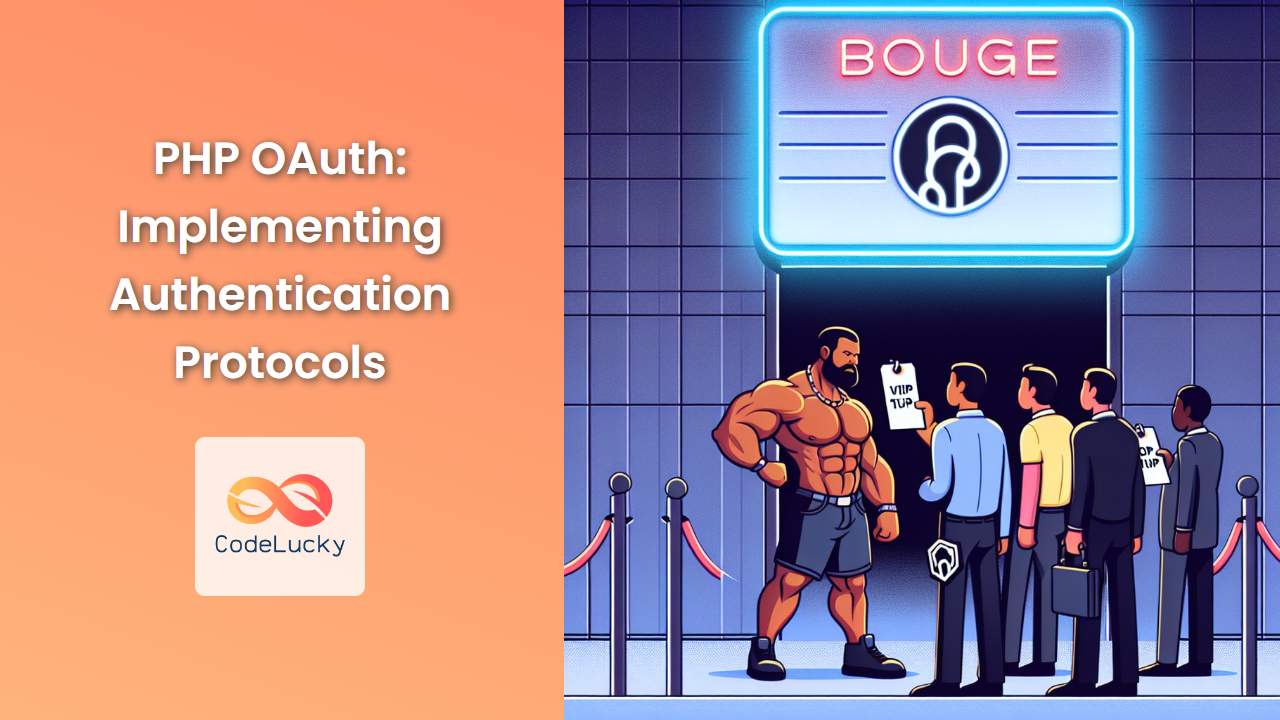In today's interconnected digital landscape, secure authentication is paramount. OAuth (Open Authorization) has emerged as a powerful protocol for enabling third-party applications to access user data without exposing sensitive credentials. In this comprehensive guide, we'll dive deep into implementing OAuth authentication protocols using PHP, empowering you to create robust and secure authentication systems for your web applications.
Understanding OAuth
Before we delve into the implementation details, let's briefly recap what OAuth is and why it's essential.
🔐 OAuth is an open standard for access delegation, commonly used as a way for Internet users to grant websites or applications access to their information on other websites but without giving them the passwords.
OAuth works on the principle of access tokens, which are issued to third-party applications with the user's approval. These tokens grant limited access to specific resources, enhancing security by eliminating the need for password sharing.
Setting Up the Environment
To get started with OAuth in PHP, we'll need to set up our development environment. Here's what you'll need:
- PHP 7.4 or higher
- Composer (for managing dependencies)
- An OAuth 2.0 client library (we'll use
league/oauth2-client)
Let's begin by installing the OAuth 2.0 client library:
composer require league/oauth2-client
Implementing OAuth with Google
We'll implement OAuth using Google as our identity provider. This example will demonstrate how to authenticate users and retrieve their basic profile information.
Step 1: Create a Google OAuth 2.0 Client ID
First, you need to create a Google OAuth 2.0 Client ID:
- Go to the Google Developers Console (https://console.developers.google.com/)
- Create a new project or select an existing one
- Enable the Google+ API
- Create credentials (OAuth client ID)
- Configure the consent screen
- Note down your Client ID and Client Secret
Step 2: Set Up the PHP Script
Now, let's create our PHP script to handle the OAuth flow. We'll name it google_oauth.php:
<?php
require_once 'vendor/autoload.php';
use League\OAuth2\Client\Provider\Google;
session_start();
$provider = new Google([
'clientId' => 'YOUR_CLIENT_ID',
'clientSecret' => 'YOUR_CLIENT_SECRET',
'redirectUri' => 'http://localhost/google_oauth.php',
]);
if (!isset($_GET['code'])) {
// If we don't have an authorization code then get one
$authUrl = $provider->getAuthorizationUrl();
$_SESSION['oauth2state'] = $provider->getState();
header('Location: ' . $authUrl);
exit;
}
// Check given state against previously stored one to mitigate CSRF attack
elseif (empty($_GET['state']) || ($_GET['state'] !== $_SESSION['oauth2state'])) {
unset($_SESSION['oauth2state']);
exit('Invalid state');
}
else {
try {
// Try to get an access token (using the authorization code grant)
$token = $provider->getAccessToken('authorization_code', [
'code' => $_GET['code']
]);
// We got an access token, let's now get the user's details
$user = $provider->getResourceOwner($token);
// Use these details to create a new profile
printf('Hello %s!', $user->getFirstName());
} catch (\Exception $e) {
// Failed to get user details
exit('Oh dear...');
}
}
Let's break down this script and understand each part:
-
We start by including the Composer autoloader and using the Google provider from the OAuth 2.0 client library.
-
We create a new
Googleprovider instance with our client ID, client secret, and redirect URI. -
If we don't have an authorization code, we generate an authorization URL and redirect the user to it.
-
When the user is redirected back to our script, we check the state parameter to prevent CSRF attacks.
-
If the state is valid, we exchange the authorization code for an access token.
-
Finally, we use the access token to retrieve the user's details and greet them by their first name.
Step 3: Handling User Data
Now that we have successfully authenticated the user and retrieved their basic information, let's expand our script to handle and display more user data:
// ... (previous code remains the same)
else {
try {
$token = $provider->getAccessToken('authorization_code', [
'code' => $_GET['code']
]);
$user = $provider->getResourceOwner($token);
// Let's display more user information
$userData = [
'Name' => $user->getName(),
'First Name' => $user->getFirstName(),
'Last Name' => $user->getLastName(),
'Email' => $user->getEmail(),
'Avatar' => $user->getAvatar(),
];
echo "<h1>Welcome, {$userData['Name']}!</h1>";
echo "<img src='{$userData['Avatar']}' alt='Profile Picture' style='width:100px;height:100px;'>";
echo "<table border='1'>";
foreach ($userData as $key => $value) {
echo "<tr><td><strong>$key</strong></td><td>$value</td></tr>";
}
echo "</table>";
} catch (\Exception $e) {
exit('Error: ' . $e->getMessage());
}
}
This enhanced version of our script retrieves additional user information and presents it in a more structured format. Here's what the output might look like:
| Field | Value |
|---|---|
| Name | John Doe |
| First Name | John |
| Last Name | Doe |
| [email protected] | |
| Avatar | https://example.com/avatar/johndoe.jpg |
Implementing OAuth with Facebook
Now that we've implemented OAuth with Google, let's explore how to do the same with Facebook. The process is similar, but there are some key differences to note.
Step 1: Create a Facebook App
- Go to the Facebook Developers site (https://developers.facebook.com/)
- Create a new app or select an existing one
- Add the Facebook Login product to your app
- Configure the OAuth settings
- Note down your App ID and App Secret
Step 2: Set Up the PHP Script
Create a new file named facebook_oauth.php:
<?php
require_once 'vendor/autoload.php';
use League\OAuth2\Client\Provider\Facebook;
session_start();
$provider = new Facebook([
'clientId' => 'YOUR_APP_ID',
'clientSecret' => 'YOUR_APP_SECRET',
'redirectUri' => 'http://localhost/facebook_oauth.php',
'graphApiVersion' => 'v12.0',
]);
if (!isset($_GET['code'])) {
$authUrl = $provider->getAuthorizationUrl([
'scope' => ['email', 'public_profile'],
]);
$_SESSION['oauth2state'] = $provider->getState();
header('Location: ' . $authUrl);
exit;
}
elseif (empty($_GET['state']) || ($_GET['state'] !== $_SESSION['oauth2state'])) {
unset($_SESSION['oauth2state']);
exit('Invalid state');
}
else {
try {
$token = $provider->getAccessToken('authorization_code', [
'code' => $_GET['code']
]);
$user = $provider->getResourceOwner($token);
$userData = [
'ID' => $user->getId(),
'Name' => $user->getName(),
'First Name' => $user->getFirstName(),
'Last Name' => $user->getLastName(),
'Email' => $user->getEmail(),
'Picture' => $user->getPictureUrl(),
];
echo "<h1>Welcome, {$userData['Name']}!</h1>";
echo "<img src='{$userData['Picture']}' alt='Profile Picture' style='width:100px;height:100px;'>";
echo "<table border='1'>";
foreach ($userData as $key => $value) {
echo "<tr><td><strong>$key</strong></td><td>$value</td></tr>";
}
echo "</table>";
} catch (\Exception $e) {
exit('Error: ' . $e->getMessage());
}
}
This script follows a similar structure to our Google OAuth implementation, with a few key differences:
- We use the
Facebookprovider instead ofGoogle. - We specify the Graph API version we're using.
- We request specific permissions (
emailandpublic_profile) in the authorization URL. - The user data we retrieve is slightly different, reflecting Facebook's API structure.
Security Considerations
When implementing OAuth, it's crucial to keep security in mind. Here are some best practices:
- 🔒 Always use HTTPS for your redirect URI and any API calls.
- 🔑 Keep your client secret secure and never expose it in client-side code.
- ⏳ Implement token expiration and refresh mechanisms.
- 🛡️ Validate the state parameter to prevent CSRF attacks.
- 🔍 Only request the permissions you absolutely need.
Conclusion
OAuth provides a secure and standardized way for applications to access user data without handling sensitive credentials directly. By implementing OAuth in your PHP applications, you can leverage the authentication systems of major providers like Google and Facebook, enhancing security and user experience.
Remember, the examples provided here are basic implementations. In a production environment, you'd want to add error handling, logging, and possibly abstract the OAuth logic into reusable classes.
As you continue to explore OAuth, consider implementing other providers, handling token refreshes, and integrating OAuth authentication with your application's user management system. With the foundation laid in this guide, you're well-equipped to build robust, secure authentication systems for your PHP web applications.
Happy coding, and may your authentication always be secure! 🚀🔐



















